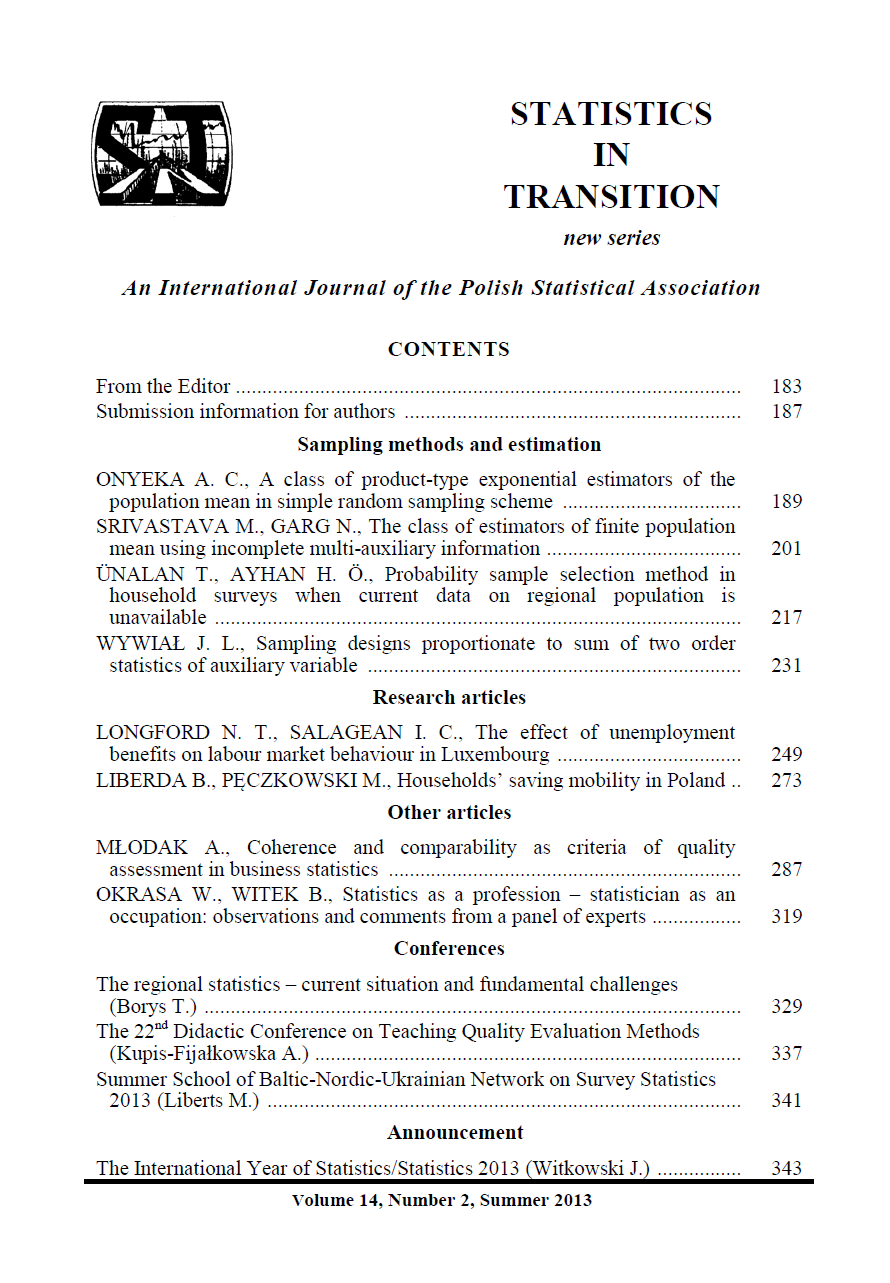ARTICLE
ABSTRACT
In this paper we examine the mobility of Polish households with regard to saving rates during the years 2007-2010 and compare it with the households’ saving mobility during the years 1997-2000. The analysis for 2007-2010 is based on the household budget panel data from three panels of 15,000 Polish households selected by authors for the years 2007-2008, 2008-2009 and 2009-2010 from the Household Budget Surveys. We use the Markov mobility matrix and estimate the long-term ergodic distribution of households according to the saving rates. Our results show that the long-term households’ distribution reveals a tendency towards polarization of households with regard to saving rates. Comparing the results for 2007-2010 with the authors’ previous research on the households’ saving mobility for a decade earlier during 1997-2000, we prove that between the years 1997-2000 and 2007-2010 the long-term change in the distribution of households was asymmetrical toward the highest saving rate groups. This helps to explain why Polish households could maintain positive and rising savings during the highly uncertain period of the financial crisis in 2007-2010.
KEYWORDS
household, saving, distribution, mobility, Markov matrix, polarization
JEL
D12, D19
REFERENCES
BAXTER, M., JERMANN, U. J., (1999). Household Production and the Excess Sensitivity of Consumption to Current Income, American Economic Review, Vol. 89, No. 4, pp. 902–920.
CAMPBELL, J. Y., (1987). Does Saving Anticipate Declining Labour Income? An Alternative Test of the Permanent Income Hypothesis, Econometrica, 55, pp. 1249–1273.
CARROLL, C. D., (1994). How Does Future Income Affect Current Consumption?, Quarterly Journal of Economics, February, pp. 111–147.
CARROLL, C. D., (2009). Precautionary Saving and the Marginal Propensity to Consume Out of Permanent Income, Journal of Monetary Economics,Vol. 56, No. 6, pp. 780–790.
DEATON, A., (1992). Understanding Consumption, Clarendon Press, Oxford.
FLAVIN, M. A., (1981). The Adjustment of Consumption to Changing Expectations about Future Income, Journal of Political Economy, Vol. 81, No. 5, pp. 974–1009.
HALL, R. E., (1978). Stochastic Implications of the Life Cycle-Permanent Income Hypothesis: Theory and Evidence, Journal of Political Economy, Vol. 86, No. 6, pp. 971–987.
Household Budget Surveys in 1997-2000 and 2007-2010, Poland, Central Statistical Office (GUS), Warsaw.
JENKINS, S. P., VAN KERM, P., (2006). Trends in income inequality, pro-poor income growth and income mobility, Oxford Economic Papers, 58(3), pp. 531–548.
KOT, S. M., (2008). Polaryzacja ekonomiczna. Teoria i zastosowanie, PWN, Warszawa.
LIBERDA, B., GÓRECKI, B., PĘCZKOWSKI, M., (2003). Uncertainty of Households’ Income in European Countries and Poland, EMERGO, Vol. 10, No. 4, pp. 2–15.
LIBERDA, B., GÓRECKI, B., PĘCZKOWSKI, M., (2004). Saving from Permanent and Transitory Income. The Case of Polish Households, Ekonomia, No. 14, pp. 7–22.
LIBERDA, B., PĘCZKOWSKI, M., (2005). Mobilność oszczędzania gospodarstw domowych w Polsce, Ekonomia, No. 17, pp. 28–42.
Metodologia badania budżetów gospodarstw domowych (Methodology of Household Budget Surveys), (2011). GUS (Central Statistical Office), Poland, Warsaw.
MODY, A., OHNSORGE, F., SANDRI, D., (2012). Precautionary Savings in the Great Recession, IMF Economic Review, Vol. 60, No. 1, pp. 114–138.
PODGÓRSKA, M., ŚLIWKA, P., TOPOLEWSKI, M., WRZOSEK, M., (2000).Łańcuchy Markowa w teorii i w zastosowaniach, Oficyna Wydawnicza SGH, Warszawa.
POTERBA, J. M., ed., (1994). International Comparisons of Household Saving, University of Chicago Press, Chicago.
QUAH, D. T., (1996). Empirics for economic growth and convergence, European Economic Review, Vol. 40, No. 6, pp. 1353–1375.
TYROWICZ, J., WÓJCIK, P., (2010). Active Labour Market Policies and Unemployment Convergence in Europe, Review of Economic Analysis, Vol. 2, No. 1, pp. 46–72.
WÓJCIK, P., (2009). Are Polish Regions Converging? Simple spatial approach, in: Civilizational competences and regional development in Poland, eds. B. Liberda, A. Grochowska, Warsaw University Press, Warsaw, pp. 87–99
